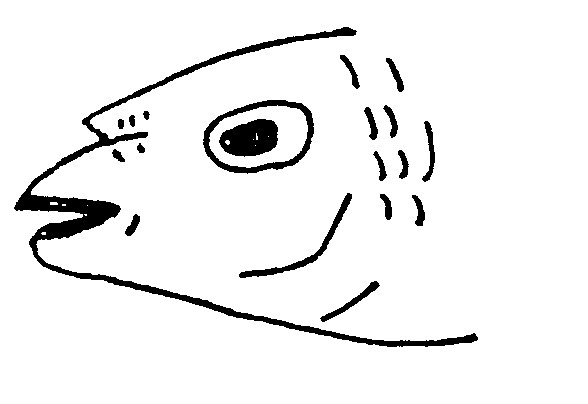Bulletin 4 - March 1978: Identification of Fishes
Identification of Fishes
by R.W. BrownIn Bulletin No.3, David Corfield illustrated four species of fish that he found on "A Short Walk in Abu Dhabi". As he was only able to identify one species I hope the following notes will identify the remaining three species.
Fish Type BProbably Leiognathus elongatus. Unfortunately I have been unable to ascertain correct English and Arabic names for this particular fish.
L. elongatus can attain a length of 10 inches at maturity and it would appear that it is not reef bound, preferring open water.
David's sketch clearly shows the unusually shaped mouth. When alive the mouth of the fish takes on a different shape, as shown below. So far it remains somewhat of a mystery as to the purpose of this unusual "hinged snout" feature.

Fish Type C
This would appear to be Scolopsus ghanam. The common English name is Peppered Grunt and the Arabic 'Bargowa' or 'Bregowa'. This fish seems to prefer shallow, weedy waters and coral areas. Its diet appears to be mainly vegetable matter (established by dissection and examination of the contents of the stomach). S. ghanam has been observed locally at lengths up to 8 inches.
Fish Type DThis would appear to be Atherina forskalii. The English name is Silverside or Sand Smelt and the Arabic 'Cheschusu'. Although thought to be an open water fish, it can often be seen in coral and rocky areas; probably in search of food.
A. forskalii is said to attain a length of 5 inches ("Fishes of the World" by Alan Cooper.)
Identification and Recording
Fish can be identified by:
(i) Body shape(ii) Coloration and Markings
(iii) Number of spines and soft rays in the fins.
Quite often (i) and (ii) are the only requirements for a positive identification. However where there are several similar fish all from the same family, it is then necessary to resort to counting the spinal rays of the fins.
It can be quite difficult to identify a fish from just a line drawing or sketch. A photograph is obviously a much better guide, especially if it is of a live fish in its natural habitat (divers with underwater cameras please note). However, dimensional line drawings are quite acceptable provided detailed information relating to the fins of the fish, particularly the dorsal and anal, is supplied (see Page 25 Bulletin No.2).
Such information forms the "Meristic Detail" of the fish and should include the number of spines and rays per fin. This detail rarely changes with age whereas body shape, colour and markings often do.
Meristic DetailThere is a recognised standard procedure that can be adopted for recording the meristic details of a fish. This is best illustrated with an example:
Acanthospagras bifasciatusType A of David Corfield's drawings has a dorsal fin comprising 11 spines and 15 rays and an anal fin of 3 spines and 12 rays. This information can be expressed as:-
D: Xl, 15A: 111, 12
Similarly the meristics of the other fish (types B, C & D) can be expressed as:-
Leiognathus elongatusD: VIII, 15
A: 14
Scolopsus ghanam
D: X, 9
A: 111, 7
Atherina forskalii
D: VI, 9
A: 1, 13
To summarise. A clear sketch, if possible indicating colouration and meristic details should greatly assist recorders in obtaining a positive identification (accompanied by a photograph, if possible).
You may discover a new species of fish, so record all the details you can!
Editor's NoteHandle the spines of unidentified fishes very carefully as some species are known to have poisonous tips, which could inflict a painful wound.